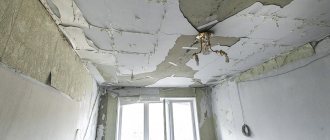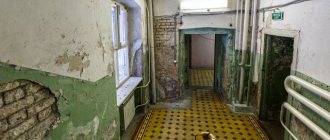According to the data available to the Ministry of Construction of the Russian Federation, at the end of 2019 in our country there were more than 54 thousand multi-apartment residential buildings that were recognized as dangerous for living in them. According to rough estimates, this is about 16 million square meters of living space, where hundreds of thousands of citizens live.
Emergency housing is not only characterized, as a rule, by the lack of necessary communications and a low level of comfort for life, but also by a significant danger for residents, since the breakdown of the house implies colossal wear and tear on the main structural elements of the building.
In this regard, federal and regional authorities are carrying out systematic legislative and practical work to quickly resettle emergency housing and reduce their share in the housing stock.
The legislative framework
Issues related to the resettlement of unsuitable housing are very complex from the point of view of organizing this process on a national scale. In this regard, their legal regulation should be comprehensive, considering both the intricacies of their financial support and the procedural procedure for carrying out the relevant work on the ground.
So, the main legal document that regulates the process of resettlement of emergency housing in terms of raising financial resources for these purposes is the federal law “On the Fund for Assistance to the Reform of Housing and Communal Services” No. 185-FZ , which was adopted back in 2007.
In accordance with this legal act, a special state fund was created, the task of which is to accumulate budget funds to resolve issues related to the overhaul of residential buildings and the resettlement of apartment buildings that are recognized as unsafe. This legal document determines the procedure for financing various targeted programs, both federal and regional, which are aimed at eliminating uninhabitable apartment buildings.
In addition, the housing rights of citizens during resettlement are established by the norms of the Housing Code of the Russian Federation. In particular, it has been established that residents of buildings and structures seized for demolition must receive residential premises of similar size. And if the tenant was the owner, then in this case he has the right to choose whether to receive a new apartment or count on adequate monetary compensation.
Issues directly related to the procedure for declaring a building unsuitable for further residence, including the corresponding procedure and timing of resettlement, are considered by a special Regulation approved by Decree of the Government of the Russian Federation No. 47 of January 28, 2006.
Reference! Existing resettlement programs, developed taking into account the designated legal acts, apply exclusively to residents of multi-apartment residential buildings.
Citizens who live in individual houses bear the burden of maintaining it exclusively at their own expense. In addition to the legal acts presented above, there are a large number of other regulatory, technical and methodological documents that affect certain aspects related to the resettlement of emergency housing.
Residents' initiative
Every citizen living in a residential building that poses a threat to human health and life must understand that government agencies cannot simultaneously control every object. Even for scheduled inspections there are schedules, and you shouldn’t expect the responsible services to show up at the behest of your sixth sense. When assessing the situation, residents of emergency buildings must take the initiative on their own by submitting appropriate applications. Such requests are accompanied by:
- Passport of each applicant, if this is a collective application;
- Title papers for housing in an apartment building (certified copies must be submitted, not originals);
- Technical and cadastral passports, plans;
- Acts of independent examinations, which record the discovery of destruction, deformation and other factors that give grounds to recognize the building as unsuitable for habitation.
Depending on the circumstances of each individual case, the specified list of documents may be supplemented. In addition, it is allowed to submit them along with the application not only during a personal visit, but also using the post office or the electronic portal of government services.
State resettlement programs
To quickly resolve issues related to the modernization of the housing stock in the Russian Federation, a special federal project was developed with a validity period until 2025, which involves a significant increase in funding for the regions in terms of relocating citizens from emergency apartments.
At the same time, funds are sent to the constituent entities of the federation on the basis of special programs. The procedure for their formation is determined by Article 16 of Federal Law No. 185-FZ.
In particular, it has been established that the use of federal funds is the responsibility of the regions. The necessary financing is carried out, in fact, at the request of the constituent entities of the federation, called the “regional targeted program for the resettlement of citizens from emergency housing stock.”
This document is formed and approved by the administration of the subject of the federation and must contain, among other things, the following:
- list of apartment buildings (with addresses);
- the timing of the resettlement of citizens from the specified apartment buildings into new comfortable houses;
- the amount of federal funding required, as well as available funds allocated for these purposes by the regional budget, as well as other sources;
- justification of the need to attract federal funds.
Important! The national resettlement program involves, for the most part, shared financing - both from the federal and regional (local) budgets.
Information regarding regional programs is not confidential and is available for study on the websites of local authorities of a particular region of the Russian Federation. In addition, you can get up-to-date information about the number of apartment buildings subject to demolition, plans for the inclusion of one or another apartment building in the program, as well as about houses already occupied on the Housing and Communal Services Reform website, located at the web address: https://www.reformagkh .ru.
Arbitrage practice
If a citizen does not agree with the amount of compensation assigned to him or when resolving the issue of resettlement he has other disagreements with the authorities, he can go to court to protect his rights.
But in this case there must be a fact of violation of the owner’s rights. Citizens often go to court when the administration offers housing that is smaller in size, in unsatisfactory sanitary condition, or has defects due to which the new apartment cannot be recognized as equivalent to the previous one.
Often, local government officials commit abuses when assessing the cost of emergency apartments, thereby violating the legal rights of citizens. In this connection, the supervisory authorities took control of the assessment.
Criteria for dilapidation and disrepair of housing
The concept of “emergency housing” is disclosed in the relevant Regulations approved by Decree of the Government of the Russian Federation on January 28, 2006 No. 47.
Among other things, this document contains criteria by which an apartment building can be recognized as an emergency.
- Physical wear and tear and impossibility of reconstruction. All erected structures and buildings wear out over time and lose their operational properties. However, physical wear and tear in itself is not a criterion for recognizing a house as unsafe as such. An apartment building unsuitable for living has significant wear and tear on the floors, foundations and load-bearing walls, combined with the impossibility of carrying out restoration work.
- Damage to a home as a result of a man-made or natural event. If a residential building was damaged as a result of a natural emergency or an explosion, fire, or collapse, a special commission evaluates the possibility of carrying out restoration work. If the latter are impractical, then the apartment building is considered unsafe and subject to demolition.
A house may be considered unsafe even if the physical wear and tear is not so great. The reason for this may be the location of the building in an area that is susceptible to various natural disasters.
In addition to emergency housing, “dilapidated housing” is also highlighted .
It should be understood as a multi-unit building with a significant process of wear and tear of the main structural elements of the building (for wooden buildings - 65%, for stone ones - 70%). However, when living in dilapidated housing there is no danger to the life and health of citizens, which distinguishes it from emergency housing.
When is this possible?
The current norms of Russian legislation define a residential building as dilapidated when its supporting structure has worn out to a certain extent. In percentage terms, a structure poses a threat to human health and life and the risk of collapse when it is worn out by more than seventy percent. At the same time, residents cannot always count on receiving a new apartment, since in addition to demolition, the building may be reconstructed.
Dear readers!
Our articles talk about typical ways to resolve legal issues, but each case is unique. If you want to find out how to solve your specific problem, please contact the online consultant form on the right →
It's fast and free!
Or call us by phone (24/7):
If you want to find out how to solve your particular problem, call us by phone. It's fast and free!
+7 Moscow,
Moscow region
+7 Saint Petersburg,
Leningrad region
+7 Regions
(toll-free call for all regions of Russia)
Before considering how apartments are given to owners when a house is demolished, you should clearly understand that visual signs of disrepair, deformation and visible damage to the structure must be documented. The higher the danger to those living in the house, the sooner this needs to be done.
Reasons to declare a house unfit for habitation:
- Availability of an official conclusion of the commission recognizing the building as unsafe, dilapidated or subject to demolition;
- Location of real estate in industrial zones, on the territory of utility networks, outside sanitary and fire safety conditions;
- Location near the site of shale mines, rock dumps, landslides;
- Ecologically unfavorable situation;
- Impossibility of providing mandatory housing and communal services for technical reasons.
Options for relocating from dilapidated houses
Current legislation provides for the following forms of resettlement of residents of emergency buildings:
- Provision of other residential premises in new houses that were built within the framework of this target program or purchased from developers for these purposes.
- Payment of monetary compensation for the owner of an apartment in a dilapidated building to purchase housing independently.
- Providing subsidies for acquisition or construction.
Housing legislation presupposes that new housing must be equal in area to the one being withdrawn, and also be suitable for living, which includes providing the necessary communications and finishing the premises. In addition, housing is issued within the same municipal area where the emergency house was located. In some cases, it is possible to issue an apartment in another municipality (district), but only with the consent of the citizen.
Owner's rights when relocating dilapidated housing
Owners of apartments located in dilapidated buildings have the following rights:
- Move to other housing in the same localities. For example, if the apartment being demolished is in the city, they cannot send the person to the village.
- Get a larger property if you are registered as needy.
- Receive the purchase price of the demolished housing instead of a new apartment.
Relocation procedure
If the house is in a regional targeted program, then resettlement will not be carried out immediately, but in several stages and according to certain rules:
- Notifying owners about the start of construction work. The local administration is obliged to notify residents of the start of the actual resettlement procedure at least one year in advance.
- Providing documents to the local administration to obtain new housing or compensation. Residents of the house provide identification documents and title documents to the administration, on the basis of which they will subsequently be allocated new housing.
- Moving out of your old home. In accordance with the direction of the municipality, residents move into new apartments. However, there are often situations when the apartment building being built for them is under construction, so during this period citizens can be relocated to temporary housing of a flexible fund.
- Obtaining ownership rights. After moving into new apartments, residents need to register ownership of housing in Rosreestr. For persons living under social rent, there is an obligation to conclude a new contract.
How does the process of declaring a house unsuitable work?
Residents of the house, representatives of local authorities or supervisory authorities can take the initiative to check housing for suitability. The procedure for assigning emergency status to a real estate property is prescribed in Decree of the Government of the Russian Federation No. 47. A decision on the condition of the house must be made by a special commission after it has carried out a full inspection in accordance with the established regulations.
It is worth considering that the concepts of dilapidated and emergency housing are different. There are special indicators that help determine whether a house is dilapidated. For a wooden building this is 65% wear, and for a stone building it is 70% wear. But, this is just a characteristic of the condition of the house, and not a compelling argument for its demolition. It is possible that the building will undergo a major overhaul. The next stage, as a result of natural wear and tear, the house is awarded emergency status. Such a building is dangerous for habitation and must be demolished.
The third part of the Resolution specifies the signs for recognizing a house as unsafe:
- the property is located near the site of a man-made disaster and may collapse at any time;
- the foundation and walls of the house are deformed and there are large cracks on them, the load-bearing walls are worn out;
- if the building has suffered from various accidents (earthquake, fire, etc.) and cannot be reconstructed;
- the property is located in an area that poses an environmental threat (high levels of noise and vibration, above normal, high concentration of harmful substances in the soil and air);
- the house is located in a place where there is an increased risk of natural disasters;
- the house is located on an area allocated for production, engineering and transport infrastructure.
Documents for recognizing a house as unsafe
The program for relocating citizens from dilapidated houses is being implemented in several stages. One of them is the submission of documents. In order for a house to be assigned emergency status, it is necessary to prepare and present the following documents:
- application to check the condition of a residential property;
- passport of the person submitting the application;
- copies of documents that will confirm the existence of property rights to housing;
- photos of defects in the building or the area around it (if this is the reason for relocation);
- complaints from residents about the condition of the house or the area around it;
- conclusion of a design and survey organization or state supervision, if the house was previously inspected.
If there are other documents that are relevant to the case and may affect its outcome, it is also better to present them.
If the house is not recognized as dilapidated, but the residents cannot live due to unsuitable living conditions
If residents do not know whether their home is participating in a relocation program, the first step is to find out if this is the case. To do this, you can submit an official request to the municipal administration or obtain information on the Housing and Communal Services Reform website.
If the house does not participate in the program, then residents must do the following:
- Submit a collective application to the municipality to recognize the house as unsafe.
- Wait for the formation of an interdepartmental commission.
- Wait for the conclusion of the interdepartmental commission.
At this stage, the house may be considered either dilapidated or in disrepair. In the first case, residents have the right to count on major repairs (with a possible temporary move to a flexible building). If the housing is recognized as unsafe, then the residents are given an approximate time frame for relocation, after which the house is included in the appropriate register.
If residents do not agree with the decision of the interdepartmental commission, then they have the right to challenge it in court. However, to do this, it is first necessary to conduct an independent examination that will confirm the tenants’ arguments.
Citizens who are owners have the right to expect compensation instead of providing housing. To do this, they need to send a corresponding application to the municipality, which is considered within 5 days. If the decision is positive, then an agreement on the transfer of property is concluded with the municipality, after which the person leaves the apartment and receives compensation to a bank account.
Attention! Tenants are required to provide confirmation of the number of family members before moving in. During the period of relocation, a new social rental agreement is concluded between the municipality and the tenant, on the basis of which it is possible to live in the new living space.
Housing in return
The mechanism for relocation from emergency housing sets certain criteria for a new property that residents will receive in return. If the old apartment was registered under the terms of a social rental agreement, the new one will be provided with the same rights. The new housing must be the same in size as the old one, located in the same region, and be ready for use. Such conditions are prescribed in Article 89 of the Housing Code of the Russian Federation. A family that needs to improve their living conditions may be given an apartment that meets social standards.
As a result, when drawing up procedures for relocation from housing that is unsuitable for living, it is necessary to distinguish between the concepts of dilapidation and disrepair. If the result of the livability test does not satisfy the residents, they can defend their rights in court.
Popular questions and answers
Question: Is it legal for the administration to demolish the house on its own?
Answer: Due to certain articles of housing legislation, residents have the right to demolish their house on their own. However, if this is refused, the municipality is obliged to do so at its own expense.
Question: Is it legal for the administration to move to flexible housing stock after eviction from old apartments?
Answer: In some cases, when living in an apartment building poses a real danger, the administration may begin resettlement on an accelerated basis. And if the new housing is not ready, the residents will be relocated to a flexible housing stock.
Question: Is it possible to sell an apartment in a building recognized as unsafe?
Answer: The owner has the right to carry out purchase and sale transactions of real estate in an emergency apartment building in the absence of encumbrances.
What results can be obtained after testing?
After conducting a home inspection, you can get the following results:
- members of the commission may not find significant deviations from the norms and then the residents will be refused relocation;
- the property is recognized as dilapidated and subject to reconstruction. Residents will be relocated to temporary housing during the renovation period;
- the entire house may be considered suitable for living, but there is no separate apartment in it. Its residents can stand in line for a new apartment, apply for subsidies, or buy new housing on their own;
- the house will be given emergency status. Such properties are sent for demolition, and a relocation mechanism is implemented for residents.
If the result of the inspection and the decision made on it do not satisfy the applicant, he has the right to file a lawsuit.
Purchase of residential premises
The Housing Code of the Russian Federation also provides for the purchase of social-type residential premises. It is carried out in connection with the demolition of an apartment building, necessary due to its dilapidated condition or the seizure of the plot of land on which the house is located. This decision is made by local governments, constituent entities of the Russian Federation or municipalities. Accordingly, it is they who carry out the purchase of the residential premises of an apartment building that is subject to demolition.
As for the cost of the redemption type, according to the regulations, it is determined by an agreement between the tenant himself and the person who buys the premises. The cost may include not only the market price, but also the losses incurred by the tenant due to these events. For example, losses may be associated with a change in your usual place of residence.
What to do if the proposed housing is not satisfactory?
It is at the discretion of the owners to sign the agreement or refuse the options proposed by the authorities. It happens that residents are not satisfied with either the new apartment or the purchase price. Especially if municipal authorities offer very bad options. For example, a 1-room apartment instead of a 2-room apartment or an insignificant amount of compensation.
Expert opinion
Semyon Frolov
Lawyer. 7 years of experience. Specialization: family, inheritance, housing law.
It is important to remember that the law is on the side of apartment owners. If a house is to be demolished, the authorities are obliged to provide equivalent housing in its place. Do not agree if you are persuaded to move to another city. Exhortations such as “the city does not have housing in your neighborhood...” are unfounded. The task of the authorities is to comply with the law and the rights of owners. If you refuse, you can safely go to court.
Although, on the other hand, if the housing option is attractive, we can agree. First, it’s worth going to the address of the new house and inspecting the apartments from the inside. It also doesn’t hurt to read reviews about the area, infrastructure, ecology, etc.









